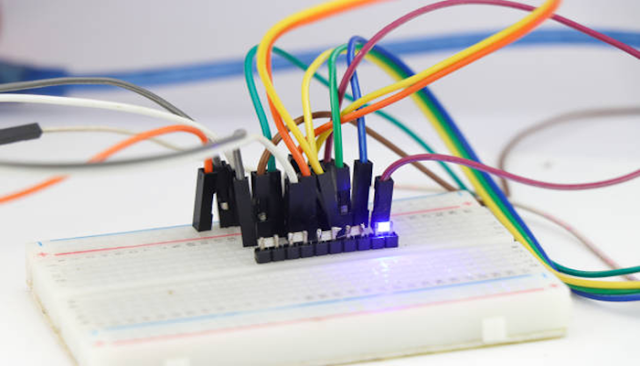In today's rapidly evolving world of electronics, Light Emitting Diodes (LEDs) have become a staple in various applications, from household lighting to automotive displays and beyond. But behind the luminous charm of LEDs, there is a crucial component that often goes unnoticed but plays a pivotal role in ensuring their optimal performance: the LED driver. In this article, we'll delve into the fundamental functions of LED drivers, explore their various types, and shed light on their applications.
The Function of an LED Driver
An LED driver is essentially the powerhouse behind LEDs, responsible for supplying the appropriate voltage and current to ensure they operate efficiently and safely. Let's break down the key functions of an LED driver:
● Voltage Regulation: LEDs require a specific voltage to function correctly. LED drivers regulate the input voltage to match the required voltage for the LED. This helps maintain a stable light output and extends the LED's lifespan.
● Current Control: Proper current control is essential to prevent LEDs from overheating or getting damaged. LED drivers maintain a constant current flow through the LEDs, ensuring they remain within their safe operating limits.
● Dimming and Brightness Control: LED drivers often support dimming capabilities, allowing you to adjust the brightness of the LEDs as per your needs. This feature is particularly valuable in applications like indoor lighting, where mood and energy savings are vital.
● Power Efficiency: LED drivers are designed to be highly efficient, ensuring that minimal power is lost as heat. This efficiency not only reduces energy consumption but also helps the LED driver remain cool, extending its lifespan.
● Protection Features: LED drivers often come equipped with protection mechanisms such as overvoltage protection, overcurrent protection, and thermal shutdown. These features safeguard the LED and the driver from damage due to unforeseen circumstances.
Now that we've uncovered the core functions of LED drivers, let's dive into the various types of LED drivers available in the market.
Types of LED Drivers
LED drivers that could be seen at any electronic parts supplier can be categorized into different types, each tailored to specific applications and requirements. Here are some common types of LED drivers:
● Constant Current LED Drivers: These drivers maintain a constant current flow through the LED, ensuring that the LED operates within its rated current limits. They are commonly used in applications where precise current control is vital, such as street lighting and automotive headlights.
● Constant Voltage LED Drivers: In applications where a stable voltage supply is required, constant voltage LED drivers are the go-to choice. They provide a fixed voltage to the LED, allowing for versatile usage, such as in LED strips and signage.
● Triac Dimmable LED Drivers: Triac dimmable LED drivers are compatible with triac dimmer switches, making them suitable for residential and commercial lighting that requires dimming capabilities. They offer smooth and flicker-free dimming, enhancing the ambiance of the space.
● DALI Dimmable LED Drivers: Digital Addressable Lighting Interface (DALI) dimmable LED drivers are prevalent in smart lighting systems. They allow individual control of each LED in a network, making them ideal for large-scale projects like office buildings and smart homes.
● PWM Dimmable LED Drivers: Pulse Width Modulation (PWM) dimmable LED drivers use a digital signal to adjust the LED's brightness rapidly. This type is commonly found in applications where rapid dimming control is required, like stage lighting and display screens.
● Emergency LED Drivers: These drivers are designed to provide power to LEDs during power outages or emergencies. They are crucial in exit signs and emergency lighting systems, ensuring safety in critical situations.
Applications of LED Drivers
Now that we've explored the functions and types of LED drivers, let's shed light on their versatile applications:
● Residential Lighting: LED drivers are widely used in residential lighting, including bulbs, downlights, and LED strips. They offer energy-efficient, dimmable, and long-lasting lighting solutions, enhancing the ambiance of homes.
● Commercial Lighting: In commercial settings, LED drivers power office lighting, retail displays, and architectural lighting. Their efficiency and dimming capabilities contribute to energy savings and create visually appealing spaces.
● Street Lighting: Constant current LED drivers are employed in street lighting systems, providing a consistent and efficient power supply to LEDs that illuminate our streets and highways, improving safety and reducing energy costs.
● Automotive Lighting: LED drivers are essential components in automotive lighting, ensuring that headlights, taillights, and interior lighting deliver optimal performance. They improve visibility and safety on the road.
● Signage and Display: Constant voltage LED drivers are common in illuminated signs, billboards, and displays. They provide the steady voltage required to make advertising and information displays pop with brightness.
● Emergency Lighting: Emergency LED drivers play a critical role in exit signs, emergency lighting fixtures, and backup lighting systems, ensuring that essential illumination is available during power interruptions or disasters.
Conclusion
In conclusion, LED drivers are the unsung heroes behind the brilliant LED displays we encounter daily. They play a vital role in regulating voltage, controlling current, and enabling dimming in LED applications, making them energy-efficient and long-lasting. Whether you're a homeowner looking to enhance your living space or an electronic parts supplier catering to diverse needs, understanding the functions, types, and applications of LED drivers is crucial for harnessing the full potential of LED technology.

No comments:
Post a Comment